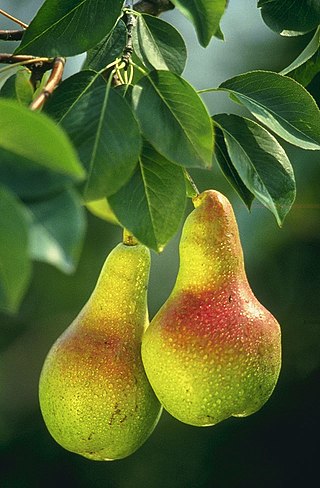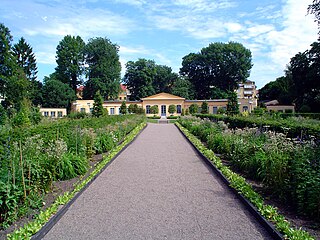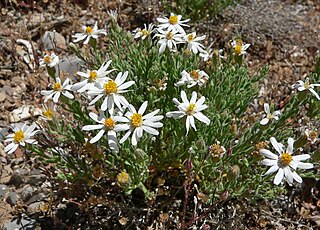
Pears are fruits produced and consumed around the world, growing on a tree and harvested in the Northern Hemisphere in late summer into October. The pear tree and shrub are a species of genus Pyrus, in the family Rosaceae, bearing the pomaceous fruit of the same name. Several species of pears are valued for their edible fruit and juices, while others are cultivated as trees.
Genus is a taxonomic rank used in the biological classification of living and fossil organisms as well as viruses. In the hierarchy of biological classification, genus comes above species and below family. In binomial nomenclature, the genus name forms the first part of the binomial species name for each species within the genus.

In taxonomy, binomial nomenclature, also called binominal nomenclature or binary nomenclature, is a formal system of naming species of living things by giving each a name composed of two parts, both of which use Latin grammatical forms, although they can be based on words from other languages. Such a name is called a binomial name, a binomen, binominal name or a scientific name; more informally it is also historically called a Latin name.
Family is one of the eight major hierarchical taxonomic ranks in Linnaean taxonomy. It is classified between order and genus. A family may be divided into subfamilies, which are intermediate ranks between the ranks of family and genus. The official family names are Latin in origin; however, popular names are often used: for example, walnut trees and hickory trees belong to the family Juglandaceae, but that family is commonly referred to as the "walnut family".
Order is one of the eight major hierarchical taxonomic ranks in Linnaean taxonomy. It is classified between family and class. In biological classification, the order is a taxonomic rank used in the classification of organisms and recognized by the nomenclature codes. An immediately higher rank, superorder, is sometimes added directly above order, with suborder directly beneath order. An order can also be defined as a group of related families.

A sepal is a part of the flower of angiosperms. Usually green, sepals typically function as protection for the flower in bud, and often as support for the petals when in bloom. The term sepalum was coined by Noël Martin Joseph de Necker in 1790, and derived from Ancient Greek σκέπη (sképē) 'covering'.
Cypress is a common name for various coniferous trees or shrubs of northern temperate regions that belong to the family Cupressaceae. The word cypress is derived from Old French cipres, which was imported from Latin cypressus, the latinisation of the Greek κυπάρισσος (kyparissos). Cypress trees are a large classification of conifers, encompassing the trees and shrubs from the cypress family (Cupressaceae) and many others with the word “cypress” in their common name. Many cypress trees have needle-like, evergreen foliage and acorn-like seed cones.
In biology, a common name of a taxon or organism is a name that is based on the normal language of everyday life; and is often contrasted with the scientific name for the same organism, which is Latinized. A common name is sometimes frequently used, but that is not always the case.

The International Code of Nomenclature for algae, fungi, and plants (ICN) is the set of rules and recommendations dealing with the formal botanical names that are given to plants, fungi and a few other groups of organisms, all those "traditionally treated as algae, fungi, or plants". It was formerly called the International Code of Botanical Nomenclature (ICBN); the name was changed at the International Botanical Congress in Melbourne in July 2011 as part of the Melbourne Code which replaced the Vienna Code of 2005.

Peter Simon Pallas FRS FRSE was a Prussian zoologist and botanist who worked in Russia between 1767 and 1810.

Gaspard Bauhin or Caspar Bauhin, was a Swiss botanist whose Pinax theatri botanici (1623) described thousands of plants and classified them in a manner that draws comparisons to the later binomial nomenclature of Linnaeus. He was a disciple of the famous Italian physician Girolamo Mercuriale and he also worked on human anatomical nomenclature.

Flora is all the plant life present in a particular region or time, generally the naturally occurring (indigenous) native plants. Sometimes bacteria and fungi are also referred to as flora, as in the terms gut flora or skin flora.
Botanical nomenclature is the formal, scientific naming of plants. It is related to, but distinct from taxonomy. Plant taxonomy is concerned with grouping and classifying plants; botanical nomenclature then provides names for the results of this process. The starting point for modern botanical nomenclature is Linnaeus' Species Plantarum of 1753. Botanical nomenclature is governed by the International Code of Nomenclature for algae, fungi, and plants (ICN), which replaces the International Code of Botanical Nomenclature (ICBN). Fossil plants are also covered by the code of nomenclature.
The International Code of Nomenclature for Cultivated Plants (ICNCP), is a guide to the rules and regulations for naming cultigens, plants whose origin or selection is primarily due to intentional human activity. It is also known as Cultivated Plant Code. Cultigens under the purview of the ICNCP include cultivars, Groups, and grexes. All organisms traditionally considered to be plants are included. Taxa that receive a name under the ICNCP will also be included within taxa named under the International Code of Nomenclature for algae, fungi, and plants, for example, a cultivar is a member of a species.

Emilia is a genus of herbaceous plants in the family sunflower family, known as tasselflower or pualele.

Joseph Pitton de Tournefort was a French botanist, notable as the first to make a clear definition of the concept of genus for plants. Botanist Charles Plumier was his pupil and accompanied him on his voyages.

Chaetopappa is a genus of plants in the family Asteraceae which are known generally as leastdaisies.
Tetraperone is a genus of flowering plants in the cosmos tribe within the daisy family.
Solenogyne is a genus of Australian plants in the tribe Astereae within the family Asteraceae.
Stilpnogyne is a genus of flowering plants in the groundsel tribe within the sunflower family.









